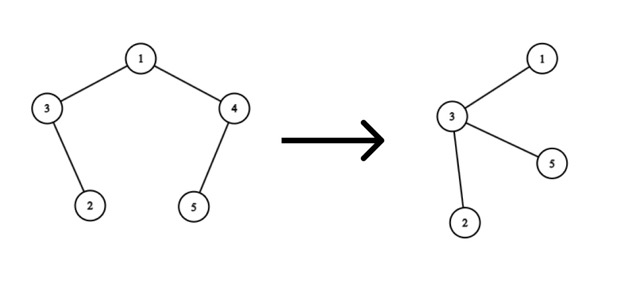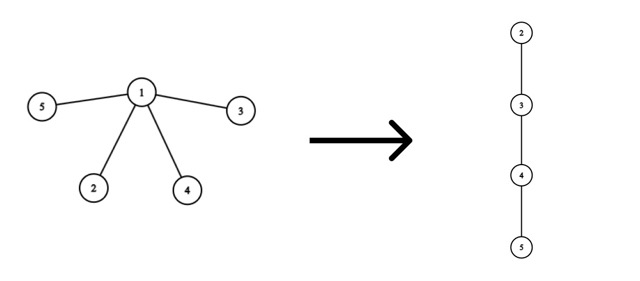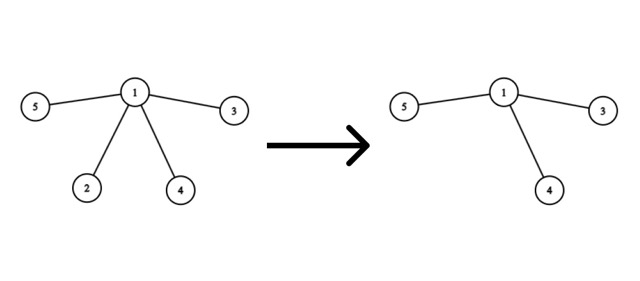CF1935F.Andrey's Tree
普及/提高-
通过率:0%
AC君温馨提醒
该题目为【codeforces】题库的题目,您提交的代码将被提交至codeforces进行远程评测,并由ACGO抓取测评结果后进行展示。由于远程测评的测评机由其他平台提供,我们无法保证该服务的稳定性,若提交后无反应,请等待一段时间后再进行重试。
题目描述
Master Andrey loves trees † very much, so he has a tree consisting of n vertices.
But it's not that simple. Master Timofey decided to steal one vertex from the tree. If Timofey stole vertex v from the tree, then vertex v and all edges with one end at vertex v are removed from the tree, while the numbers of other vertices remain unchanged. To prevent Andrey from getting upset, Timofey decided to make the resulting graph a tree again. To do this, he can add edges between any vertices a and b , but when adding such an edge, he must pay ∣a−b∣ coins to the Master's Assistance Center.
Note that the resulting tree does not contain vertex v .
Timofey has not yet decided which vertex v he will remove from the tree, so he wants to know for each vertex 1≤v≤n , the minimum number of coins needed to be spent to make the graph a tree again after removing vertex v , as well as which edges need to be added.
† A tree is an undirected connected graph without cycles.
输入格式
Each test consists of multiple test cases. The first line contains a single integer t ( 1≤t≤104 ) — the number of test cases. The description of the test cases follows.
The first line of each test case contains a single integer n ( 5≤n≤2⋅105 ) — the number of vertices in Andrey's tree.
The next n−1 lines contain a description of the tree's edges. The i -th of these lines contains two integers ui and vi ( 1≤ui,vi≤n ) — the numbers of vertices connected by the i -th edge.
It is guaranteed that the given edges form a tree.
It is guaranteed that the sum of n over all test cases does not exceed 2⋅105 .
输出格式
For each test case, output the answer in the following format:
For each vertex v (in the order from 1 to n ), in the first line output two integers w and m — the minimum number of coins that need to be spent to make the graph a tree again after removing vertex v , and the number of added edges.
Then output m lines, each containing two integers a and b ( 1≤a,b≤n,a=v,b=v , a=b ) — the ends of the added edge.
If there are multiple ways to add edges, you can output any solution with the minimum cost.
输入输出样例
输入#1
3 5 1 3 1 4 4 5 3 2 5 4 2 4 3 3 5 5 1 5 2 1 1 5 1 4 1 3
输出#1
1 1 3 4 0 0 1 1 1 2 2 1 3 5 0 0 0 0 0 0 1 1 1 2 1 1 1 2 1 1 1 2 3 3 2 3 4 5 3 4 0 0 0 0 0 0 0 0
说明/提示
In the first test case:
Consider the removal of vertex 4 :
 The optimal solution would be to add an edge from vertex 5 to vertex 3 . Then we will spend ∣5−3∣=2 coins.
The optimal solution would be to add an edge from vertex 5 to vertex 3 . Then we will spend ∣5−3∣=2 coins.
In the third test case:
Consider the removal of vertex 1 :
 The optimal solution would be:
The optimal solution would be:
- Add an edge from vertex 2 to vertex 3 , spending ∣2−3∣=1 coin.
- Add an edge from vertex 3 to vertex 4 , spending ∣3−4∣=1 coin.
- Add an edge from vertex 4 to vertex 5 , spending ∣4−5∣=1 coin.
Then we will spend a total of 1+1+1=3 coins.
Consider the removal of vertex 2 :
 No edges need to be added, as the graph will remain a tree after removing the vertex.
No edges need to be added, as the graph will remain a tree after removing the vertex.